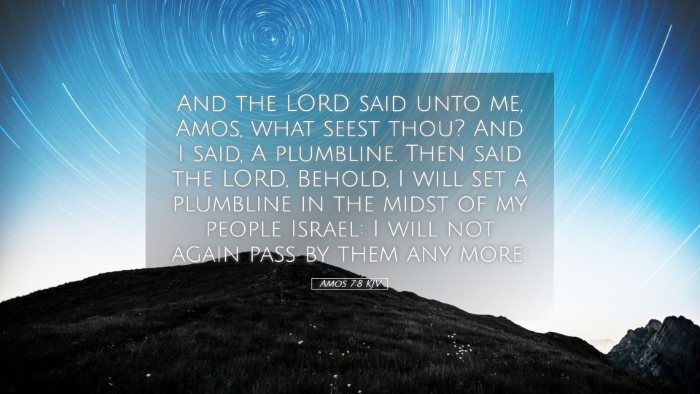Old Testament
Genesis Exodus Leviticus Numbers Deuteronomy Joshua Judges Ruth 1 Samuel 2 Samuel 1 Kings 2 Kings 1 Chronicles 2 Chronicles Ezra Nehemiah Esther Job Psalms Proverbs Ecclesiastes Song of Solomon Isaiah Jeremiah Lamentations Ezekiel Daniel Hosea Joel Amos Obadiah Jonah Micah Nahum Habakkuk Zephaniah Haggai Zechariah MalachiAmos 7:8
Amos 7:8 KJV
And the LORD said unto me, Amos, what seest thou? And I said, A plumbline. Then said the LORD, Behold, I will set a plumbline in the midst of my people Israel: I will not again pass by them any more:
Amos 7:8 Bible Commentary
Commentary on Amos 7:8
The verse Amos 7:8 states:
“And the Lord said to me, ‘Amos, what do you see?’ And I said, ‘A plumb line.’ Then the Lord said, ‘Behold, I am setting a plumb line in the midst of my people Israel; I will never again pass by them.’”
This passage is profound and pivotal as it symbolizes God's judgment and the standards to which His people are held. The imagery of the plumb line serves multiple layers of meaning in the prophetic narrative, which has been interpreted and expounded by various commentators throughout history.
Symbolism of the Plumb Line
Matthew Henry notes that the plumb line signifies God’s judgment and the necessity of alignment with His holiness. It is a tool that determines what is upright and what is crooked, emphasizing that God's evaluations are thorough and just. God shows Amos what He sees, demonstrating that He is aware of the moral and spiritual state of Israel. The plumb line serves as a metric for assessing whether the people are aligned with God’s standards.
Albert Barnes asserts that this image serves as a token of divine inspection. God is telling Amos that He is measuring Israel against His righteous standard. The adoption of such a measurement reflects God’s desire for His people to be upright in character, faith, and action. The plumb line reminds us of the need for self-examination and the introspection of scriptural values within the community of faith.
Adam Clarke expands on this metaphor by describing the plumb line as a decisive mark of judgment. Clarke suggests that God’s judgment is not arbitrary; it is based on a clear and established standard. The plumb line is indicative of the infusion of divine truth, which can pinpoint the deviations of Israel from God's commandments. Clarke emphasizes the urgency of returning to righteousness as a community.
Contextual Understanding
Henry reminds us that the broader context of Amos' prophecy critiques the social injustices and spiritual apathy prevalent in Israel. The plumb line exemplifies divine patience, yet its establishment signals an impending judgment. This plurality of meaning illuminates both hope for restoration and fear of condemnation:
- The plumb line shows that God is active in His covenantal relationship with Israel.
- Israel is held accountable not only to God but also to each other in how they treat one another.
- Amos's role as a prophet reflects the call for societal renewal through alignment with God’s standards.
Barnes further clarifies that the vision of the plumb line occurs after a series of other prophetic visions, which show the depth of sin and the necessity of repentance. This specific vision is God's declaration for an assessment of Israel's spiritual architecture. It poses a challenge for the audience to comprehend the seriousness of their spiritual state—which leads to the question of whether they are building a life that honors God.
Clarke notes that this passage invites pastors and theologians to reflect on their congregations and spiritual leadership models. Just as Amos brought God's message to Israel, contemporary ministers are called to measure their communities against the truths of Scripture. The evaluation is not for condemnation but for correction, guiding believers back to alignment with God’s perfect will.
Theological Implications
The presence of a plumb line indicates that God is actively involved in the moral and spiritual conditions of His people. Henry eloquently points out that this image reassures believers that God’s standards remain clear and constant, promoting the understanding that divine justice is always righteous. God will not overlook sin forever; however, there is a pathway for restoration through sincere repentance.
Barnes highlights the relational aspect of this judgment—God’s commitment to His people means He desires their holiness. The plumb line not only signifies judgment but also serves as God’s unchanging truth toward which humanity must orient their lives.
Likewise, Clarke emphasizes that the plumb line represents a call to action—the necessity for all believers, especially those in positions of leadership, to cultivate a culture of accountability grounded in Scripture. There is a universal call to examine our spiritual lives, churches, and movements in light of God’s established standards.
Application for Today's Believers
Amos 7:8 serves as a timeless reminder of the standards by which God measures nations and individuals. For pastors and scholars, the following applications emerge:
- Encourage congregations to engage in personal and communal reflection to ensure alignment with God’s truths.
- Utilize the metaphor of the plumb line in sermons and teachings to illustrate the need for spiritual uprightness.
- Address social injustices within the church, linking them back to the biblical commandments that God desires His people to uphold.
Moreover, this passage calls for continued vigilance regarding moral integrity within the faith community. Henry encapsulates this urgency by stating that God’s judgment operates on a continuum—there is always an opportunity for repentance before the plumb line leads to ultimate judgment.
Barnes posits that this verse offers hope; even if God’s judgment appears imminent, there persists an avenue for mercy. Engaging with this text encourages believers to lean into God’s presence and invite His correction into their lives.
Finally, Clarke suggests that community leaders must not only preach a message of imminent correction but also embody the hope of God’s redemptive plan. Each believer's journey should be viewed through the lens of restoration rather than mere observation of law.
Conclusion
Amos 7:8, with its powerful imagery of a plumb line, encapsulates a divine challenge for alignment with God’s will. The insights from these esteemed commentators –Matthew Henry, Albert Barnes, and Adam Clarke—emphasize the critical nature of self-examination in light of God’s holy standards. This passage maintains relevance not only for ancient Israel but for all believers today as they navigate the complexities of faith and moral living in a world fraught with challenges.
The reverberations of this divine metaphor call for a spiritual realignment and an invitation to sit at the feet of God, holding ourselves accountable to His truths as we collectively seek to embody His righteousness in a broken world.


